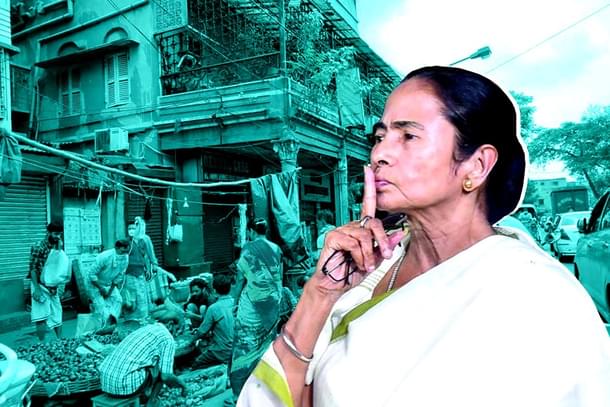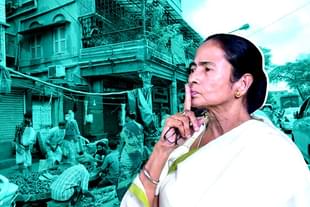Politics
Bengal’s Actual Covid-19 Death Toll Busts Mamata Banerjee Government’s ‘All Is Well’ Buster
Jaideep Mazumdar
May 01, 2020, 07:37 PM | Updated 07:41 PM IST
Save & read from anywhere!
Bookmark stories for easy access on any device or the Swarajya app.


The devil, as is often said, lies in the details. So is the case with Bengal: recent official statistics and actions belie the state’s claim that Bengal has been successful in controlling the coronavirus (Covid-19) pandemic.
Chief Secretary Rajiva Sinha announced on Thursday that the Covid-19 casualty toll stood at 33, a 50 per cent jump from the previous day’s figure of 22. Sinha explained that the ‘expert audit committee’ set up by the state government to certify coronavirus-caused deaths had examined 105 deaths so far, but found that 72 of them had died of co-morbidities (pre-existing illnesses) even though they had tested positive for Covid-19.
However, going by WHO (World Health Organization) and ICMR (Indian Council of Medical Research) guidelines, all the 105 ought to be counted as Covid-19 casualties. According to Thursday evening’s state health bulletin, the total number of active cases in Bengal at present is 572. A total of 139 patients have recovered and been discharged.
If the 105 deaths are added to the number of active cases and discharged patients, the total number of people who have been infected by the virus in Bengal till now stands at 816. That would give Bengal a case fatality ratio (CFR) — percentage of Covid-19 patients who died — of 13 per cent, which is much above that of all other states and also the national average.
This CFR is 4 per cent for Maharashtra (10,498 cases and 459 deaths) and less than 5 per cent in Gujarat (4,395 cases and 214 deaths), the two worst-affected state in the country. The all-India CFR is 3.3 per cent. The CFR for Delhi, another badly-affected state, is 1.6 per cent.
Epidemiologists say that Bengal’s high CFR is primarily due to very poor handling and treatment of Covid-19 patients, the abysmal infrastructure in state-run hospitals, low testing levels and alarming community transmission of the virus.
Bengal’s high CFR is not just an ordinary statistic, but one that hides a grave story about the (pandemic) condition prevailing in the state.
“The high percentage of casualties means that very serious cases are being admitted to hospitals. That only means that testing has been very low in Bengal, otherwise more positive cases would have been detected at early stages and sent to hospitals for treatment,” said an epidemiologist at a state-run hospital who did not want to be named.
A series of exposes, including leaks of official advisories, have revealed that testing of even symptomatic patients was being allowed only after obtaining permission from the state health authorities.
It was only on Wednesday that this directive was shelved and doctors were allowed to refer all symptomatic cases for swab tests. But by then, grave damage had been done and the state had been pushed into a deep crisis.
There have also been many exposes about the lack of facilities in the state-run hospitals designated as exclusive facilities for treating Covid-19 patients.
An account by a relative of a physician who passed away at M R Bangur Hospital earlier this week about how the physician died without any treatment and describing the horrific condition at the hospital went viral.
The number of beds with ventilators at both the Infectious Diseases Hospital and Bangur Hospital (the two state-run hospitals for treating Covid-19 patients) is grossly inadequate and that is why, say physicians, many Covid-19 patients are dying at these hospitals.
The high CFR in Bengal also points to the alarming spread of the virus in the state. Epidemiologists say that this is primarily due to extremely lax enforcement of lockdown restrictions and non-adherence to social distancing norms.
Chief Minister Mamata Banerjee’s express instructions to the police force to be soft on violators (‘no barabari’, meaning don’t use excessive force) hampered strict enforcement of the lockdown, unlike in all other states.
Her misguided Muslim-appeasement policy led to police allowing people to move around unhindered in Muslim-inhabited areas of Kolkata and other parts of the state. These, obviously, led to the spread and community transmission of the virus.
Banerjee’s decision to allow markets selling vegetables, fish, meat and even flowers to remain open led to overcrowding in these markets. By the time the state machinery started enforcing social distancing norms and the lockdown with a modicum of strictness about a week ago, it was already too late.
That Bengal is in a deep crisis and the situation is only worsening with every passing day is also evident from another official statistic.
Thursday (30 April) saw the total number of containment zones in Kolkata going up by 37 to 264. That means the coronavirus has spread wildly in 264 areas of the city, necessitating the total lockdown of these areas in order to stop the spread of the virus to other areas.
The total number of containment zones in the state stands at 444, up from 227 three days ago. Most of these are in Kolkata and its neighbouring North 24 Parganas and Howrah districts.
“The sharp and continuing rise in the number of these red (containment) zones is proof that the virus is spreading wildly and the transmission is going beyond control,” said another epidemiologist.
That Bengal continues to be ill-prepared, and that the state government lacks the wherewithal to tackle this pandemic is also evident from the state administration’s appeal to private hospitals to earmark more beds for treating Covid-19 patients.
The chief secretary and the West Bengal Clinical Establishment Regulatory Commission have asked private hospitals to scale up the beds meant for Covid-19 patients.
However, there are reportedly no plans to scale up infrastructure in the state-run hospitals to admit more Covid-19 patients or designate more state-run hospitals for such patients.
“That’s because the state just does not have the resources for enhancing the capacity to treat Covid-19 patients in government hospitals. State run hospitals are in a mess and lack the required equipment and facilities, and doctors and staff there don’t have PPEs, to handle Covid-19 patients,” said a senior physician, who was associated with the super-speciality SSKM Hospital until last year.
The pandemic situation in Bengal, say epidemiologists and public health experts, is spiralling out of control. Sadly, they say, there is little that can be done now to arrest the downslide to disaster.
Jaideep Mazumdar is an associate editor at Swarajya.





